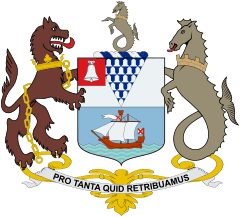Sir Thomas and Lady Dixon Park
Coordinates: 54°32′28″N 5°58′48″W / 54.541°N 5.980°W The Sir Thomas and Lady Dixon Park is a park in South Belfast, Northern Ireland, covering almost 130 acres (0.53 km2) and is accessible from the Upper Malone Road.[1] It includes meadows, woodland, riverside fields, formal rose gardens, a walled garden and a Japanese garden, as well as a children's playground, coffee shop, an orienteering course and many walks.[2] It is owned by the people of belfast and maintained by Belfast City Council's Parks and Amenities Section.[3] On 14 July 2010, the park hosted annual International Rose Trials, the highlight of Rose Week, involving judges from around the world.
Features
The City of Belfast International Rose Garden in the Park has made it world-famous. In the summer it contains over 40,000 roses, divided into trial and display beds, a historical section and a heritage garden that displays the best roses from local breeders.[2] It also has a Diana, Princess of Wales memorial garden.[4] The rose garden and events like Rose Week attract thousands of visitors each year. The park also features International Camellia Trials.[2] There are red and grey squirrels in the woodland.[5]
History
The park was bequeathed to the people of Belfast in 1959 by Lady Edith Stewart Dixon and was dedicated to the memory of her husband, the late Sir Thomas Dixon.[1] The first roses were planted in 1964 and the Trial roses were judged for the first time in summer 1965. A permanent panel of judges is provided by the Rose Society of Northern Ireland, formed by Craig Wallace in 1964.[3]
Wilmont House
Wilmont House, in the grounds of the park, was built in the early 1760s by Scottish farming family the Stewarts, who were among the first to grow carrots on a large scale in the early 19th century. In 1811 an early threshing machine was erected on the property. The last Stewart associated with the house was James, who mortgaged the property to the Northern Banking Company in 1844, ending almost a century of family connections. The estate changed hands several times before James Bristow, a director of the Northern Banking Company, was granted a lease to the property in 1858. He commissioned the building of the present Wilmont House (in 1859), designed by one of Belfast's most important Victorian architects, Thomas Jackson. Bristow's initials are inscribed in stone on the north side of the house. The estate was sold to Robert Reade in 1897 following the deaths of the Bristow male heirs. After he died in 1913, his son sold it to Sir Thomas Dixon for £21,500 in 1919.[6] Dixon was a prosperous Ulster businessman who served as High Sheriff of Antrim and was knighted. Lady Dixon became a Dame Commander of the Order of the British Empire (DBE) for her work for the armed forces during World War I. Prince Henry, Duke of Gloucester, was a guest in 1935 and General Collins of the United States Army was billeted at Wilmont House during World War II. Sir Thomas Dixon died in 1950 and in 1959 Wilmont House and the estate was presented to Belfast Corporation “for the greatest good of the citizens of the City of Belfast” by Lady Dixon in memory of her husband. The park opened the same year. From 1963 to 1988 Wilmont House served as a nursing home. Lady Dixon died in 1964, aged 92.[7] The fountain situated in the park was renovated and a new fountain commissioned for the Queen's Golden Jubilee year.[6] The Walled Garden used to provide fruit and vegetables for the house, which has a dummy window, painted on the brickwork to balance the exterior.[5]
Gallery
-

Japanese garden, 2002
-
Shady pond, 2006
-
Rose Garden, 2006
-
Meadow and woodland, 2006
-

Rose in International Rose Week 2006
References
- 1 2 "Sir Thomas and Lady Dixon Park". Belfast City Council. Retrieved 5 August 2010.
- 1 2 3 "Sir Thomas and Lady Dixon Park". Discover Northern Ireland. Retrieved 5 August 2010.
- 1 2 "The City of Belfast International Rose Garden, Sir Thomas & Lady Dixon Park". World Federation of Rose Societies. Retrieved 5 August 2010.
- ↑ "City of Belfast International Rose Garden". Belfast City Council. Retrieved 5 August 2010.
- 1 2 "Sir Thomas and Lady Dixon Park - Trail Route" (PDF). Belfast City Council. Retrieved 5 August 2010.
- 1 2 "Ulster Walks: Sir Thomas and Lady Dixon Park". Belfast Telegraph (by Linda McKee, 18 October 2008). Retrieved 5 August 2010.
- ↑ "Sir Thomas and Lady Dixon Park". Disabled Ramblers Northern Ireland. Retrieved 5 August 2010.
Further reading
- Scott, Robert 2004. Wild Belfast on safari in the city. The Blackstaff Press Belfast. ISBN 0-85640-762-3
